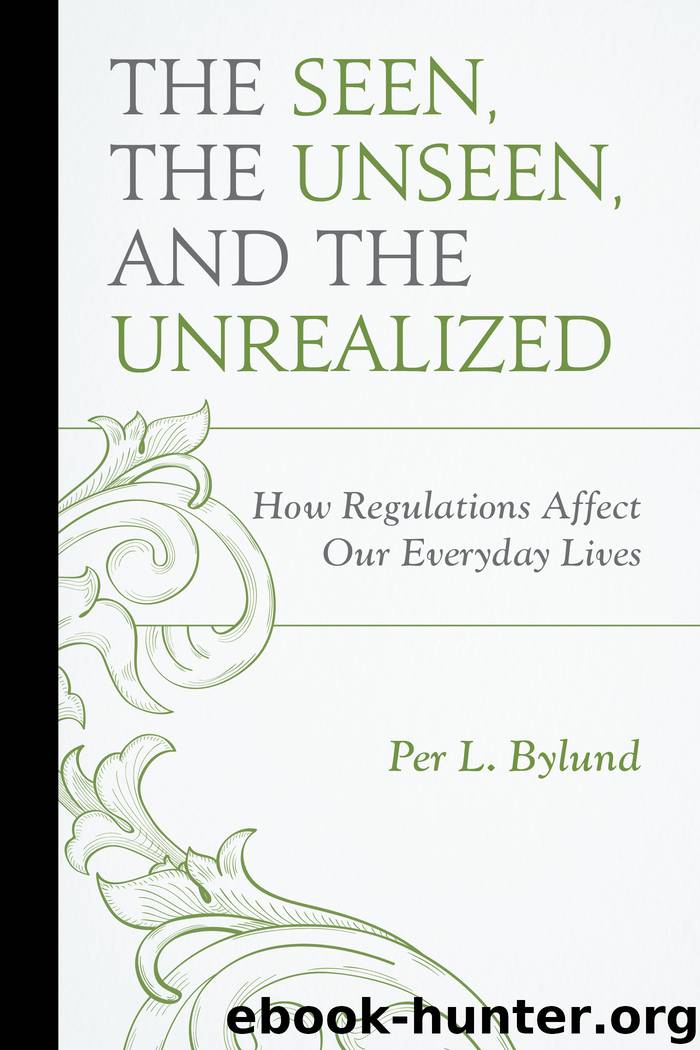The Seen, the Unseen, and the Unrealized by Bylund Per L

Author:Bylund, Per L.
Language: eng
Format: epub
Tags: undefined
Publisher: Lexington Books, a division of Rowman & Littlefield Publishers, Inc.
Published: 2012-09-18T16:00:00+00:00
Disaster
A disaster, whether it is devastation due to natural forces such as earthquakes, volcanic eruptions, tsunamis, and hurricanes or man-made destruction from wars or rent control,[3] can, economically speaking, be understood as an abrupt and radical increase in scarcity. While the apple scab is also an increase in scarcity (the scab diminishes the supply of apples), it affects a single good and one that is likely inessential for the population. Disasters, in contrast, have a huge impact on the supply of essential goods such as food, shelter, and power; they greatly reduce the supply—or even wipe it out—and therefore put people in a very delicate situation. In other words, they create abject scarcity of essential goods within a very short time frame.
For it to be a disaster, the change needs to be unanticipated. As we discussed above, market production is continuously adjusted toward the anticipated future by entrepreneurs attempting to outdo each other by finding a better use for resources available or invented. If the supply of essential goods is dramatically reduced but the change is anticipated, then prices and production structures have already been adjusted to account for this change, and the disastrous effects are therefore mitigated if not even avoided. A disaster is therefore different from other radical change because it is rarely anticipated if at all as well as affecting most or all goods across the board.
So how would the “market” respond to for instance an earthquake that breaks bridges in two, wrecks and flattens houses, and causes mayhem? The answer is no different from above: by finding prices where supply meets demand and by reallocating resources toward their better uses. Following a disaster, there are fewer resources available than before but there are still resources. Of course, the initial and direct response to a disaster is likely to be in the form of community and voluntary efforts rather than organized for-profit entrepreneurship: neighborhood communities, churches, families, and other associations, new and old, get together to pool their resources in order to help those in greatest need. For example, temporary hospitals would be set up and run by volunteers, people would get together in teams for organized search and rescue, and temporary shelters would be made for those without. These community and volunteer efforts should not be discounted or underestimated, but they too will benefit from the market response.
At some point, and following a disaster this would happen rather soon, the affected region will fall short of and therefore need supplies from elsewhere—as well as produce their own to the degree possible. Both of these, which aim to increase supply, are primarily economic activities, and can thus be explained using the template from above. Two responses are needed: increased inflow of necessary and needed goods, and reallocation of remaining resources toward the now more highly valued needs (shelter, food, water, etc.).
The increased inflow of goods from elsewhere is accomplished in two ways, both of which are important. First, there is the voluntary and community-based relief efforts through
Download
This site does not store any files on its server. We only index and link to content provided by other sites. Please contact the content providers to delete copyright contents if any and email us, we'll remove relevant links or contents immediately.
International Integration of the Brazilian Economy by Elias C. Grivoyannis(90789)
The Radium Girls by Kate Moore(11921)
Turbulence by E. J. Noyes(7935)
Nudge - Improving Decisions about Health, Wealth, and Happiness by Thaler Sunstein(7615)
The Black Swan by Nassim Nicholas Taleb(7010)
Rich Dad Poor Dad by Robert T. Kiyosaki(6399)
Pioneering Portfolio Management by David F. Swensen(6226)
Man-made Catastrophes and Risk Information Concealment by Dmitry Chernov & Didier Sornette(5921)
Zero to One by Peter Thiel(5685)
Secrecy World by Jake Bernstein(4643)
Millionaire: The Philanderer, Gambler, and Duelist Who Invented Modern Finance by Janet Gleeson(4374)
The Age of Surveillance Capitalism by Shoshana Zuboff(4209)
Skin in the Game by Nassim Nicholas Taleb(4161)
Bullshit Jobs by David Graeber(4094)
The Money Culture by Michael Lewis(4075)
Skin in the Game: Hidden Asymmetries in Daily Life by Nassim Nicholas Taleb(3929)
The Dhandho Investor by Mohnish Pabrai(3698)
The Wisdom of Finance by Mihir Desai(3650)
Blockchain Basics by Daniel Drescher(3503)
